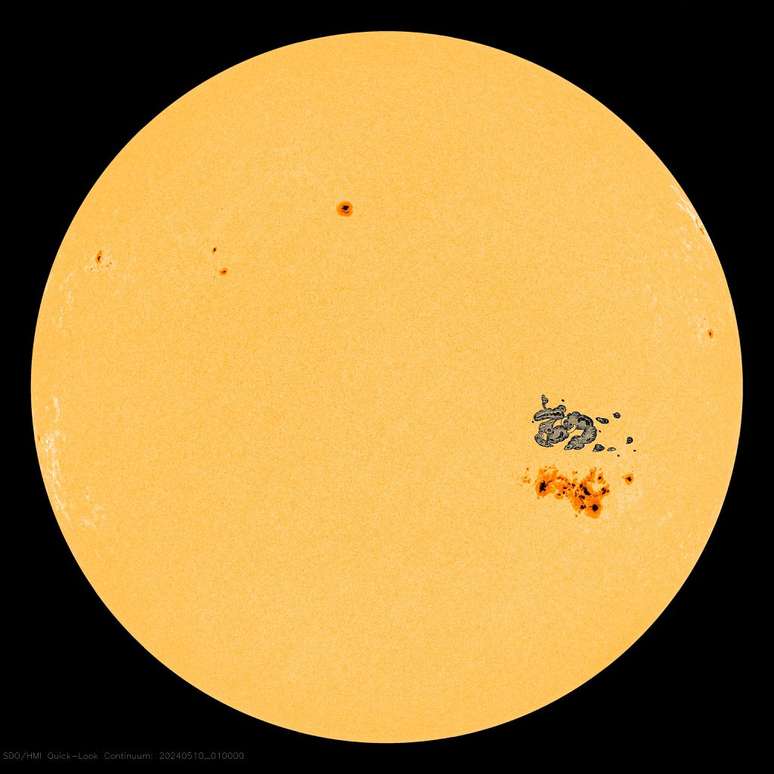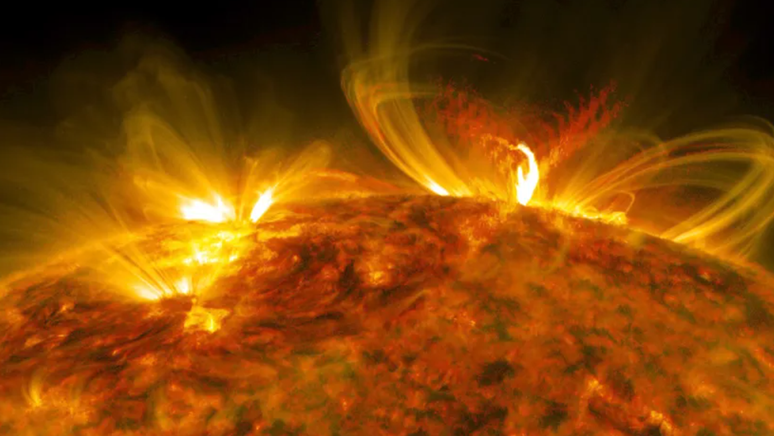The spot that caused the May 10 solar storm has reappeared on the Sun, bringing with it stronger eruptions
The famous sunspot AR3664, responsible the largest solar storm in 21 years, is back. He survived a full rotation of our star and reappeared on the Earth-facing side, causing more intense explosions. Check the Sun’s activity in the last few days.
- The May solar storm was so strong that we detected it on the sea floor
- See photos of the Northern Lights after an extreme solar storm
Sunspot AR3664
On May 10th this year the Earth was hit the largest geomagnetic storm since 2005. The event was characterized by northern Lights and southern regions in various regions of the planet, including latitudes where these phenomena do not usually occur.
In the following hours the storm, until then classified as G4 (strong), evolved into G5 (extreme), the maximum classification on the scale used by scientists. This made it the strongest since the 2003 Halloween storm.

The event was caused by a series of solar phenomena, starting from the complex twisting of the Sun’s magnetic fields, resulting in the formation of Sunspots. This process is common and occurs most frequently during the peaks of the 11-year solar cycles.
In May, magnetic twists formed the AR3664 sunspot region, which soon became almost as large as that of the famous Carrington Event, the largest solar storm in recorded history. AR3664 was so large that 15 Earths could fit in a row.
After the events of the May 10 solar storm, the giant spot completed half a rotation of the Sun and hid on the far side of our star. In other words, it was no longer in front of us.
Huge glow! Although not visible from Earth, old AR 13664 (responsible for recent solar storms) just gave off its biggest flare yet! Measured by the Solar Orbiter spacecraft behind the Sun, the glow is estimated to be X12-class. This flare also caused a huge CME behind the Sun. pic.twitter.com/i9cYgRzdOc
— Doctor Ryan French (@RyanJFrench) May 20, 2024
During this period he emitted great explosions,
, which ended up hitting Venus (above) and breaking all records of the current 11-year cycle. After another intense eruption, it completed an entire solar rotation and reappeared on the left side of the solar disk. Now its name is AR3697.
This spot still had a lot to show us, and it proved it with a huge explosion rated X2.8. But perhaps there’s a problem here: This event may have been much more powerful than it appears.
The problem with the X2.8 classification is that, at the spot’s current location, none of the spacecraft that monitor solar flares (SDA, Solar Orbiter, and the ground-based telescopes themselves) can observe it in full. It is as if AR3664 is in a blind spot, from where we can only see part of the eruptive emissions.
Close-up view of the Memorial Day X2.8 glow. This is an animation of SDO/AIA 171 Å images. Note the ring oscillations immediately after the eruption and the subsequent growth (apparent upward movement) of the post-flare rings. pic.twitter.com/rJPzXfJmiK
— Halo ECM (@halocme) May 28, 2024
Textbook example of a coronal mass ejection from our old friend AR3664 this morning: pic.twitter.com/gRXvyDk3sp
— Doctor Adam Finley (@AdamF_Astro) May 27, 2024
This means that scientists cannot estimate with much conviction the size of the eruption that this place brought us. In any case, although the event triggered a coronal mass ejection (CME) – a cloud of plasma that generates solar storms – it will not reach our planet.
In the video above you saw the enigmatic explosion (X2.8 or greater) of AR3697 (formerly AR3664), while the one below shows the CME triggered by this event. This is the welcome they welcome us with, warning that it may cause many more Aurora Borealis/Southern Lights.
Past solar activities
Other interesting events have attracted the attention of scientists seeking to better understand the mechanism behind solar storms. One was the eruption of a huge plasma filament on the 23rd, which triggered a CME that caused a weak geomagnetic storm on the 26th.
On the 24th, an incredible eruption further illuminated the right side of the solar disk, without significant consequences for our planet.
New great commercials coming soon
In addition to AR3697 (formerly 3664), there are two other large sunspots on the side away from the Sun that should appear on the side facing Earth: the regions 3670 and 3673, which could bring some surprises.
Tracking spacecraft observing our distant star shows that they are magnetically complex and capable of producing large events. These spots should appear on the visible side of the Sun within about 5 days. With all this news, we can expect some radio blackouts in the coming days.
Trends on Canaltech:
- VinFast VF 3 | Electric Jipinho is a sales success on Shopee
- The magnetic anomaly affecting Brazil is growing and moving
- It is FALSE that the Earth will be “much further” from the Sun! Understand what aphelion is
- China creates an army of robot dogs equipped with weapons
- 😱 ANOTHER FALLEN | Buy Galaxy S23 Ultra 256 GB at an unmissable price
- Mondial Turbo Citrus Review | Good and cheap citrus juicer
Source: Terra
Rose James is a Gossipify movie and series reviewer known for her in-depth analysis and unique perspective on the latest releases. With a background in film studies, she provides engaging and informative reviews, and keeps readers up to date with industry trends and emerging talents.








